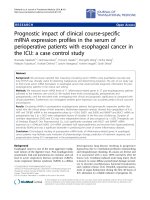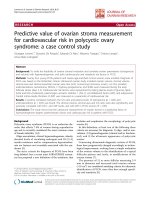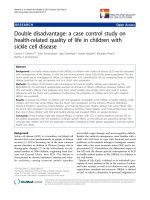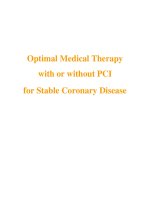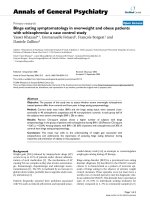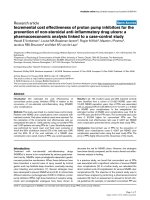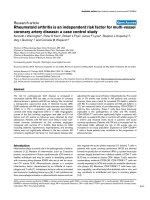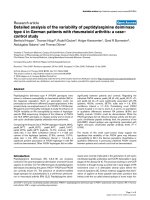Concurrent chemoradiotherapy with or without cetuximab for stage II to IVb nasopharyngeal carcinoma: A case–control study
Bạn đang xem bản rút gọn của tài liệu. Xem và tải ngay bản đầy đủ của tài liệu tại đây (771.49 KB, 11 trang )
Li et al. BMC Cancer (2017) 17:567
DOI 10.1186/s12885-017-3552-6
RESEARCH ARTICLE
Open Access
Concurrent chemoradiotherapy with or
without cetuximab for stage II to IVb
nasopharyngeal carcinoma: a case–control
study
Yang Li1,2†, Qiu-Yan Chen1,2†, Lin-Quan Tang1,2†, Li-Ting Liu1,2, Shan-Shan Guo1,2, Ling Guo1,2, Hao-Yuan Mo1,2,
Ming-Yuan Chen1,2, Xiang Guo1,2, Ka-Jia Cao1,2, Chao-Nan Qian1,2, Mu-Shen Zeng1, Jin-Xin Bei1, Jian-Yong Shao1,3,
Ying Sun1,4, Jing Tan1, Shuai Chen1, Jun Ma1,4, Chong Zhao1,2† and Hai-Qiang Mai1,2*†
Abstract
Background: This study aimed to evaluate the long-term outcome and toxicities in patients with locoregionally
advanced nasopharyngeal carcinoma (NPC) treated by concurrent chemoradiotherapy (CCRT) with/without adding
cetuximab.
Methods: A total of 62 patients treated with CCRT plus cetuximab were matched with 124 patients treated with
CCRT alone by age, sex, pathological type, T category, N category, disease stage, radiotherapy (RT) technique,
Epstein-Barr virus (EBV) DNA levels, and Eastern Cooperative Oncology Group (ECOG). Overall survival (OS),
progression-free survival (PFS), locoregional recurrence-free survival (LRFS), and distant metastasis-free survival
(DMFS) were assessed using the Kaplan–Meier method and log-rank test. Treatment toxicities were clarified and
compared between two groups.
Results: A total of 186 well-balanced stage II to IV NPC patients were retrospectively analyzed (median follow-up,
76 months). Compared to CCRT alone, adding cetuximab resulted in more grade 3 to 4 radiation mucositis (51.6% vs.
23.4%; P < 0.001). No differences were found between the CCRT + cetuximab group and the CCRT group in 5-year OS
(89.7% vs. 90.7%, P = 0.386), 3-year PFS (83.9% vs. 88.7%, P = 0.115), the 3-year LRFS (95.0% vs. 96.7%, P = 0.695), and the
3-year DMFS (88.4% vs 91.9%, P = 0.068). Advanced disease stage was the independent prognostic factor predicting
poorer OS and PFS.
Conclusion: Adding cetuximab to CCRT did not significantly improve benefits in survival in stage II to IV NPC and
exacerbated acute mucositis and acneiform rash. Further investigations are warranted.
Keywords: Cetuximab, Intensity-modulated radiotherapy, Nasopharyngeal carcinoma, Cisplatin, Concurrent
chemotherapy, Clinical outcome
* Correspondence:
†
Equal contributors
1
State Key Laboratory of Oncology in South China; Collaborative Innovation
Center for Cancer Medicine,Sun Yat-Sen University Cancer Center, Guangzhou,
People’s Republic of China
2
Department of Nasopharyngeal Carcinoma, Sun Yat-Sen University Cancer
Center, 651 Dongfeng Road East, Guangzhou 510060, People’s Republic of China
Full list of author information is available at the end of the article
© The Author(s). 2017 Open Access This article is distributed under the terms of the Creative Commons Attribution 4.0
International License ( which permits unrestricted use, distribution, and
reproduction in any medium, provided you give appropriate credit to the original author(s) and the source, provide a link to
the Creative Commons license, and indicate if changes were made. The Creative Commons Public Domain Dedication waiver
( applies to the data made available in this article, unless otherwise stated.
Li et al. BMC Cancer (2017) 17:567
Background
Nasopharyngeal carcinoma (NPC) is an endemic carcinoma in Southern China and Southeast Asia, especially in the Guangdong province, with an annual
incidence of 20–30 per 100,000 population [1–3].
Radiotherapy (RT) is the primary treatment, and several prospective randomized trials and meta-analyses
have supported the use of combined radiotherapy
and chemotherapy [4–10]. NCCN Clinical Practice
Guidelines in Oncology recommended concurrent
chemoradiotherapy (CCRT) with or without adjuvant
chemotherapy as the standard treatment protocol for
stage II–IV NPC [11].
Despite improved treatment modalities and techniques yielding excellent survival outcomes, 20%–30%
of patients die of distant and/or local-regional relapse
[12]. To improve this result, therapies involving molecular targets such as epidermal growth factor receptor (EGFR) have been studied extensively over the
last decade. High levels of EGFR have been observed
in 80% of patients with locoregionally advanced NPC
and it is associated with poor clinical outcome [13].
Cetuximab, an anti-EGFR antibody, showed a survival
benefit in patients with locoregionally advanced head
and neck squamous cell carcinoma (HNSCC) when
combined with RT [14]. In NPC, a phase II study
showed that cetuximab combined with carboplatin
demonstrates clinical activity for recurrent or metastatic NPC patients with previous treatment failure
with platinum-based therapy [15]. The preliminary
report of the ENCORE study demonstrated a promising clinical response in using cetuximab combined
with CCRT in NPC [16]. A phase II study conducted
by Ma et al. reported that concurrent cetuximabcisplatin and intensity-modulated radiotherapy in
locoregionally advanced NPC was feasible and preliminary survival outcomes compared favorably with
historic data [17].
However, currently there are still no randomized trials
that have been conducted to directly compare the outcome of CCRT alone versus concomitant cetuximab as a
first-line treatment of Stage II to IVb NPC. Therefore,
the purpose of this study is to compare the long-term
outcome and toxicities of the NPC patients treated by
CCRT with or without adding cetuximab used as a
matched case-control study.
Methods
Patients diagnosed with nasopharyngeal carcinoma at
our institution between January 2007 and April 2014
were identified, as a total of 7385 patients. The eligibility criteria included the following: (1) untreated,
newly diagnosed NPC without distant metastasis; (2)
biopsy- confirmed World Health Organization (WHO)
Page 2 of 11
type II-III NPC; (3) 18 ~ 70 years old; (4) without
secondary malignancy, pregnancy, or lactation. Ultimately, 1971 patients were included in the study
population, of them 1909 patients received CCRT
alone, and only 62 patients received CCRT with
cetuximab due to the expensive cost of treatment. In
the 1:2 match, patients who received cetuximab plus
CCRT were individually matched to two control patients receiving CCRT alone according to age, sex,
pathological type, T category, N category, disease
stage, RT technique, EBV DNA levels, and ECOG.
The inclusion and exclusion criteria are summarized
in Fig. 1.
Pretreatment assessments
All patients were evaluated by a complete physical
assessment, hematologic and biochemical profiles,
nasopharyngoscopy, MRI or enhanced CT of the
nasopharynx and neck (CT was only used in patients
with contraindication to MRI), chest scan (X-ray or
CT), abdominal sonography, bone scan, and plasma
level of EBV DNA. The plasma level of EBV DNA
was measured by real-time quantitative polymerase
chain reaction (PCR) [18, 19].
Concurrent chemotherapy and cetuximab
All patients were treated with CCRT using cisplatin
chemotherapy.
Cisplatin
was
administered
at
80 ~ 100 mg/m2 triweekly for at least 2 cycles or at
30 ~ 40 mg/m2 weekly for 5 ~ 7 cycles during radiotherapy. In the CCRT group, 64 (51.6%) patients received
80–100 mg/m2 cisplatin triweekly and 60 (48.4%) received 30–40 mg/m2 cisplatin weekly. In the CCRT plus
cetuximab group, 39 (62.9%) patients received triweekly
cisplatin, while weekly cisplatin was administered to 23
(37.1%) patients. The patients in the cetuximab plus
CCRT group received a loading dose of cetuximab
400 mg/m2 1 week before RT and thereafter a weekly
dose of 250 mg/m2 during RT for 6 ~ 7 cycles of
treatment.
Radiotherapy
All patients were treated with radiotherapy delivered
as five fractions per week, among them, 30 patients
underwent conventional RT using two-dimensional
technique (2D–CRT) and 156 patients received
intensity-modulated radiotherapy (IMRT). Details of
the RT techniques applied at our Cancer Center at Sun
Yat-Sen University have been reported previously [20, 21]
in conformity with the International Commission on
Radiation Units and Measurements Reports 50 and
62. The patients treated with 2D–CRT received total
radiation doses of 70–76 Gy to the primary tumor at
2 Gy per fraction, 62–66 Gy to the involved areas of
Li et al. BMC Cancer (2017) 17:567
Page 3 of 11
Fig. 1 Study flow diagram. NPC, nasopharyngeal carcinoma; SYSUCC, Sun Yat-Sen University Cancer Center; CCRT, concurrent chemoradiotherapy;
EBV DNA: Epstein-Barr virus deoxyribonucleic acid; ECOG PS: Eastern Cooperative Oncology Group performance status
the neck, and 50 Gy to the uninvolved areas. The patients received IMRT with variable 2.12 to 2.24 Gy
fractions daily for 5 days per week up to a total of
68–72 Gy (median 70 Gy).
Outcome and follow-up
The primary endpoint for this study was overall survival (OS), which was calculated from the date of
treatment to the date of death from any cause. The
secondary endpoints for the study were progressionfree survival (PFS), distant failure-free survival
(DMFS), locoregional failure-free survival (LRFS), and
toxicity profile. PFS was calculated from the date of
treatment to the date of locoregional failure, distant
failure, or death from any cause, whichever occurred
first. DMFS was defined as the date of treatment to
first distant metastasis, and LRFS was defined as the
date of treatment to first locoregional relapse. The
Common Terminology Criteria for Adverse Events
(CTCAE) version 4.0 was used to grade treatmentrelated acute toxicities. Acute and late radiationrelated complications were scored according to the
Radiation Therapy Oncology Group (RTOG)/the
European Organization for Research and Treatment
of Cancer (EORTC) Late Radiation Morbidity Scoring
Schema [22]. All the patients were followed after
treatment. Patients were evaluated every 3 months
during the first 2 years, and then every 6 months
thereafter until death.
Statistical analysis
Statistical analyses were performed using SPSS software (Version 22.0, SPSS Inc., Chicago, IL, USA).
The actuarial survival rates were described with
Kaplan–Meier method and survival curves were compared with the log-rank test. Fisher’s exact tests and
χ2 test were used to assess categorical variables, and
hazard ratios (HRs) were estimated using the Cox
proportional hazards models. Covariates included in
the univariate and multivariate analyses were smoking history, disease stage, EBV DNA level, VCA-IgA,
EA-IgA, BMI, C-reactive protein (CRP), and family
history of cancer. All statistical tests were two-sided,
and the criterion for statistical significance was set at
P < 0.05.
Results
Patient characteristics and treatment compliance
A total of 168 patients were enrolled in this study.
There were 62 cases in the cetuximab plus CCRT
group and 124 controls. The groups were well
matched for age, sex, pathological type, T category, N
category, disease stage, RT technique, EBV DNA
levels, and ECOG. Patient characteristics and treatment factors are detailed in Table 1. All patients
completed planned RT. In terms of chemotherapy,
103 patients received triweekly cisplatin, among
whom 39 (62.9%) and 64 (51.6%) patients were from
cetuximab plus CCRT group and CCRT group,
Li et al. BMC Cancer (2017) 17:567
Page 4 of 11
Table 1 Baseline patient demographic and clinical
characteristics
CCRT with cetuximab CCRT group
group (n = 62)
(n = 124)
Age, years
Table 1 Baseline patient demographic and clinical
characteristics (Continued)
P value
1
Mean
46.32 (25–64)
1
Male
50 (80.6%)
100 (80.6%)
Female
12 (19.4%)
24 (19.4%)
Pathological type
1
WHO type II
3 (4.8%)
4 (3.2%)
WHO type III
59 (95.2%)
120 (96.8%)
T category
1
T2
14 (22.6%)
28 (22.6%)
T3
41 (66.1%)
82 (66.1%)
T4
7 (11.3%)
14 (11.3%)
N category
1
N0
6 (9.7%)
12 (9.7%)
N1
25 (40.3%)
50 (40.3%)
N2
28 (45.2%)
56 (45.2%)
N3
3 (4.8%)
6 (4.8%)
Disease stage
1
II
5 (8.1%)
10 (8.1%)
III
47 (75.8%)
94 (75.8%)
IVA
7 (11.3%)
14 (11.3%)
IVB
3 (4.8%)
6 (4.8%)
RT technique
1
2DRT
10 (16.1%)
20 (16.1%)
IMRT
52 (83.9%)
104 (83.9%
Cisplatin delivery
0.144
2
Every 3 weeks(80–100 mg/m ) 39 (62.9%)
64 (51.6%)
Weekly (30–40 mg/m2)
60 (48.4%)
23 (37.1%)
EBV DNA level
1
< 4000 copies
35 (56.5%)
70 (56.5%)
≥ 4000 copies
27 (43.5%)
54 (43.5%)
VCA-IgA
1
< 1:80
15 (24.2%)
30 (24.2%)
≥ 1:80
47 (75.8%)
94 (75.8%)
EA-IgA
0.148
< 1:10
24 (38.7%)
35 (28.2%)
≥ 1:10
38 (61.3%)
89 (71.8%)
ECOG
1
0
1 (1.6%)
2 (1.6%)
1
61 (98.4%)
122 (98.4%)
LDH,U/L
0.666
< 245
61 (98.4%)
120 (96.8%)
≥ 245
1 (1.6%)
4 (3.2%)
0.286
< 3.00
49 (79.0%)
89 (71.8%)
13 (21.0%)
35 (28.2%)
< 18.5
3 (4.8%)
5 (4.0%)
≥ 18.5
59 (95.2%)
119 (96.0%)
Yes
20 (32.2%)
59 (47.6%)
No
42 (67.7%)
65 (52.4%)
Yes
13 (21.0%)
11 (8.9%)
No
49 (79.0%)
113 (91.1%)
≥ 3.00
46.05 (28–66)
Sex
CRP,g/ml
Body mass index, kg/m
2
1
Smoking
0.46
Family history of cancer
0.02
Abbreviations: CCRT concurrent chemoradiotherapy, WHO World Health
Organization, 2DRT two-dimensional radiotherapy, IMRT intensitymodulated radiotherapy, EA early antigen, VCA viral capsid antigen, IgA
immunoglobulin A, EBV DNA Epstein-Barr virus DNA, ECOG Eastern
Cooperative Oncology Group, CRP C-reactive protein, LDH serum lactate
dehydrogenase levels
respectively. The remaining 83 patients received
weekly cisplatin, with 23 (37.1%) patients from cetuximab plus CCRT group and 60 (48.4%) patients from
CCRT group. In cetuximab plus CCRT group and
CCRT group, 60 (96.8%) and 120 (96.8%) patients received at least 2 cycles of triweekly cisplatin or 5 cycles of weekly cisplatin, respectively. Appendix 1:
Table 6 lists the specifics of chemotherapy in both
groups. The percentages of patients dropping out
from treatment due to toxicities were nonsignificantly different between the two groups. In the
group of adding cetuximab, 52 (83.9%) patients received six or more weekly cetuximab doses. 9 (14.5%)
patients stopped using cetuximab as a result of
toxicity.
Toxicities
Table 2 lists the distribution of adverse effects. Significant differences only in terms of mucositis were
observed between the two treatment groups (51.6%
with cetuximab vs. 23.4% without; P < 0.001). The
rate of 10% weight loss was statistically different
(66.1% with cetuximab vs. 50.8% without; P = .047).
The incidence of cetuximab-related acneiform rash in
the cetuximab group was 75.8%. Grade 2 cetuximabrelated acneiform rash in the CCRT with cetuximab
group was reported in 15 (24.2%) patients. Only one
(1.6%) patient developed grade 3 acneiform rash
toxic effect and no patient had grade 4 toxic effect.
No patient in the CCRT group had acneiform rash.
No significant differences of grade 3–4 toxicity in
neutropenia, neutropenia, anemia, thrombocytopenia,
Li et al. BMC Cancer (2017) 17:567
Page 5 of 11
Table 2 Cumulative adverse events during treatment by maximum grade per patient during treatment
Toxic effects, No. (%)
P value*
CCRT alone (n = 124)
Neutropenia
CCRT + cetuximab(n = 62)
Grade 1
Grade 2
Grade 1
Grade 2
Grade 1–2
34 (27.4%)
49 (39.5%)
16 (25.8%)
18 (29.0%)
0.107
Leucopenia
36 (29.0%)
24 (19.4%)
17 (27.4%)
13 (21.0%)
1
Anemia
44 (35.5%)
23 (18.5%)
3 (4.8%)
5 (8.1%)
< 0.001
Thrombocytopenia
19 (15.3%)
10 (8.1%)
5 (8.1%)
3 (4.8%)
0.091
AST increased
17 (13.7%)
3 (2.4%)
9 (14.5%)
1 (1.6%)
1
ALT increased
22 (17.7%)
11 (8.9%)
31 (50.0%)
4 (6.5%)
< 0.001
BUN
9 (7.3%)
1 (0.8%)
2 (3.2%)
1 (1.6%)
0.549
CRE
13 (10.5%)
0
2 (3.2%)
0
0.087
Mucositis
36 (29.0%)
54 (43.5%)
9 (14.5%)
21 (33.9%)
0.001
Dermatitis
73 (58.9%)
26 (21.0%)
28 (45.2%)
23 (37.1%)
0.694
Vomiting
47 (37.9%)
17 (13.7%)
35 (56.5%)
11 (17.7%)
0.003
Weight loss
42 (36.8%)
56 (49.1%)
14 (23.7%)
39 (66.1%)
0.298
Acneiform rash
0 (0.0%)
0 (0.0%)
31 (50.0%)
15 (24.2%)
-
Toxic effects, No. (%)
P value*
CCRT alone (n = 124)
Neutropenia
CCRT + cetuximab(n = 62)
Grade 3
Grade 4
Grade 3
Grade 4
18 (14.5%)
1 (0.8%)
8 (12.9)
0 (0.0%)
0.097
Leucopenia
8 (6.5%)
1 (0.8%)
4 (6.5%)
0 (0.0%)
1
Anemia
2 (1.6%)
0 (0.0%)
2 (3.2%)
0 (0.0%)
0.602
Thrombocytopenia
4 (3.2%)
1 (0.8%)
1 (1.6%)
0 (0.0%)
0.665
AST increased
0
0
0
0
-
ALT increased
2 (1.6%)
0
1 (1.6%)
0
1
Renal impairment
0
0
0
0
-
BUN
0
0
0
0
-
CRE
0
0
0
0
-
Mucositis
29 (23.4%)
0 (0.0%)
29 (46.8%)
3 (4.8%)
< 0.001
Dermatitis
5 (4.0%)
0 (0.0%)
3 (4.8%)
0 (0.0%)
1
Vomiting
2 (1.6%)
0 (0.0%)
2 (3.2%)
1 (1.6%)
0.335
Weight loss
0
-
2 (3.2%)
-a
0.110
a
Data are n or n (%). *P values were calculated with the χ2 test (or Fisher’s exact test). aAccording to the Common Terminology Criteria for Adverse Events (version
4.0), weight loss has only grade 1–3
Abbreviations: CCRT concurrent chemoradiotherapy, AST aspartate aminotransferase, ALT alanine aminotransferase, BUN blood urea nitrogen, CRE creatinine
liver and kidney dysfunction, dermatitis, vomiting, or
weight loss were found between the two groups.
With respect to late complications, no significant differences of grade 2–4 toxicity in xerostomia and
hearing loss were found between the two groups.
(Table 3.)
Survival
The median follow-up duration for the entire cohort
was 76 months (range, 4–114 months), 76 months
(range, 4–107 months) for the cetuximab plus CCRT
group, and 76 months (range, 5–114 months) for the
controls. No significant differences were found between
groups in OS, PFS, LRFS, or DMFS (Table 4, Fig. 2.).
The 5-year probabilities for OS were 89.7% (95% CI,
81.9% to 97.5%) for the CCRT with cetuximab group
and 90.7% (95% CI, 85.4% to 96.0%) for the CCRT group
(P = 0.386). The 3-year PFS rates of the CCRT with
cetuximab group and the CCRT group were 83.9% (95%
CI, 74.7% to 93.1%) and 88.7% (95% CI, 83.0% to 94.4%)
(P = 0.115), respectively. The 3-year LRFS and DMFS
Li et al. BMC Cancer (2017) 17:567
Page 6 of 11
Table 3 Late toxicities in patients treated with cetuximab + CCRT
versus CCRT
Late toxicity
Cetuximab + CCRT
(n = 62)
CCRT
(n = 124)
P
Xerostomia*
11 (17.7%)
27 (21.8%)
0.52
Hearing loss*
13 (21.0%)
23 (18.5%)
0.694
Skin dystrophy
3 (4.8%)
5 (4.0%)
1
Neck fibrosis
6 (9.7%)
17 (13.7%)
0.431
Trismus
2 (3.2%)
11 (8.9%)
0.263
Radiation encephalopathy
1 (1.6%)
9 (7.3%)
0.108
Cranial nerve palsy
7 (11.3%)
9 (7.3%)
0.364
*Grade 2–4 toxicities
*grade 2-4 toxicities
rates of the CCRT with cetuximab group vs. the CCRT
group were 95.0% (95% CI, 89.5% to 100%) vs. 96.7%
(95% CI, 93.6% to 99.8%) (P = 0.695), 88.4% (95% CI,
80.4% to 96.4%) vs. 91.9% (95% CI, 87.0% to 96.8%)
(P = 0.068), respectively.
Multiple variables including familial history, smoking
history, body mass index (BMI), tumor factors (i.e., disease stage, EBV DNA levels, VCA-IgA, and EA-IgA),
and intervention (i.e., whether using cetuximab) were
Table 4 Five years (%) OS (overall survival), PFS (progression-free
survival), (distant metastasis-free survival), LRRFS (locoregional
relapse-free survival) and HRs with 95% CI
CCRT plus
cetuximab
group (%)
CCRT
group (%)
Hazard
ratioa
N = 62
N = 124
(95% CI)
Deaths
6
11
_
Rate at 5 years
89.7%
90.7%
0.705
(81.9–97.5)
(85.4–96.0)
(0.318–1.560)
P value
Overall survival
0.386
Progression-free survival
Progression
13
19
_
Rate at 5 years
77.6%
84.5%
0.607
(66.6–88.5)
(78.0–91.0)
(0.324–1.137)
_
0.115
Locoregional relapse-free survival
Locoregional relapses
3
7
Rate at 5 years
95.0%
94.0%
0.803
(89.5–100)
(89.7–98.3)
(0.269–2.403)
0.695
Distant metastasis-free survival
Distant metastases
10
12
_
Rate at 5 years
82.0%
90.3%
0.489
(71.8–92.2)
(85.0–95.6)
(0.223–1.072)
0.068
Data are n (%) or rate (95% CI). aHazard ratios were calculated with the
unadjusted Cox proportional hazards model. P values were calculated
with the unadjusted log-rank test
analyzed by a multivariable analysis to predict outcomes
for the whole population. Advanced disease stage was an
independent prognostic factor predicting poorer OS and
PFS (Table 5).
Discussion
Controversy remains regarding the additional benefit of
cetuximab to concomitant chemoradiotherapy, which is
the primary regimen for stage II–IV NPC. Appendix 2:
Table 7. listed the related studies. Our matched casecontrol study aimed to clarify the feasibility and efficacy
of cetuximab combined with CCRT among stage II–IV
NPC patients.
Historically, the treatment of HNSCC with concurrent cetuximab and RT provides survival benefit when
compared to RT alone. Bonner et al. conducted a
multinational, randomized study to compare radiotherapy alone with radiotherapy plus cetuximab in the
treatment of locoregionally advanced squamous-cell
carcinoma of the head and neck, which found a survival advantage associated with the use of cetuximab
delivered in conjunction with radiation [14]. However,
a large randomized phase III trial of Radiation Therapy Oncology Group (RTOG) 0522 [23] in head and
neck squamous-cell carcinoma (HNSCC), which
tested whether the addition of cetuximab to cisplatinRT were more effective, demonstrated that no discernable benefit and an increase in toxicity from adding cetuximab to radiation-cisplatin and hence should
not be prescribed routinely.
In NPC, to date, studies in terms of cetuximab
added to CCRT in NPC have been conducted showing that it is safe, effective, and tolerated [17, 24],
while none of them was with a direct comparison of
CCRT. An retrospective matched case–control study
[25] on concurrent cetuximab-based bioradiotherapy
(BRT) or cisplatin-based chemoradiotherapy (CRT) in
patients with NPC suggested equivalence between
these two treatments. In this study, the 5-year OS
rates in patients in the BRT group was similar to patients treated with CRT (79.5% vs. 79.3%, P = 0.797).
T. Xu et al. earlier reported a randomized phase II
study [26] on patients with NPC who received concurrent cetuximab-based radiotherapy (ERT). This
study demonstrated that ERT was not more efficacious than concurrent cisplatin-IMRT. In our study,
we also disappointed to discover that patients in
CCRT + cetuximab group achieved a 5-year OS rate
similar to patients treated with re-RT+/−chemotherapy
(89.7% vs. 90.7%, P = 0.386), and in PFS, LRFS, or
DMFS there are also no significant improvements.
Survival outcomes in this study seemed much higher
than our experience [17, 24, 27] with concurrent
cisplatin and radiotherapy—either with or without
Li et al. BMC Cancer (2017) 17:567
Page 7 of 11
Fig. 2 Kaplan–Meier estimates of (a) progression-free and (b) overall survival and cumulative incidence estimates of (c) locoregional failure and
(d) distant metastasis by assigned treatment. HR, hazard ratio; CCRT, Concurrent Chemoradiotherapy
cetuximab. It may be due to an unbalanced distribution of disease stages in our study, in which the percentages of II, III, and IV stage patients were 8.1%,
75.8%, and 16.1%, respectively. Faced with these negative results, a plausible explanation could be that
cetuximab and cisplatin have similar mechanisms of
radiation sensitization [28, 29]. So tumors turned out
to be resistant to both agents, and sensitive tumors
would derive no additional benefit. In further study,
refine study populations based on some new biologic
tumor features or biomarkers, which were proved to
be associated with radiation resistance or metastasis,
to define patients who will benefit from cetuximab
should be carefully considered.
In regard to toxicity, mucositis is the most common
toxicity reported by studies regarding cetuximab
combined with radiotherapy in head and neck. Notwithstanding, a pivotal trial by Bonner suggested that
cetuximab did not exacerbate mucositis associated
with radiotherapy of the head and neck [14]. In daily
practice, though not clearly supported in the literature, the rate of mucositis with RT/CRT plus cetuximab seems higher, especially in Asians. Ethnic and
lifestyle habits may play a role [30]. A randomized
phase II study [26] mentioned before showed using
cetuximab with RT was more likely to cause grade 3/
4 oral mucositis than cisplatin-based CRT in locally
advanced NPC. Ma et al. [17] also reported that using
cetuximab with CCRT caused a high rate of grade 3–
4 mucositis of 87% in locally advanced NPC. In this
study, we found that the incidence of moderate-tosevere mucositis in the CCRT with cetuximab group
was significantly higher than that in the CCRT group
(51.6% vs. 23.4%, P < 0.05). The possible mechanism
why cetuximab plus cisplatin add more severe oral
mucositis are as followed. The epithelial cells of the
Li et al. BMC Cancer (2017) 17:567
Page 8 of 11
Table 5 Cox regression model of multivariable analysis for
overall survival and progression-free survival
HR (95% CI)
P value
1.457 (0.639 ~ 3.322)
0.371
Overall survival
Cetuximab (yes vs. no)
Smoking history (yes vs. no)
1.217 (0.537 ~ 2.757)
0.638
Disease stage (IV vs. II–III)
5.052 (2.194 ~ 11.631)
< 0.001
EBVDNA (≥ vs. < 4000 copies)
2.072 (0.878 ~ 4.893)
0.096
BMI (≥vs. < 23 kg/m2)
0.84 (0.373 ~ 1.893)
0.674
CRP (≤ vs. >3.0 g/ml)
0.736 (0.267 ~ 2.027)
0.553
VCA-IgA (< vs. ≥ 1:80)
0.877 (0.209 ~ 3.687)
0.858
EA-IgA (< vs. ≥ 1:10)
0.894 (0.24 ~ 3.326)
0.867
Family history of cancer (yes vs. no)
0.953 (0.271 ~ 3.346)
0.94
1.85 (0.956 ~ 3.58)
0.068
Progression-free survival
Cetuximab (yes vs. no)
Smoking history (yes vs. no)
0.917 (0.47 ~ 1.79)
0.8
Disease stage (IV vs. II–III)
3.747 (1.823 ~ 7.704)
< 0.001
EBVDNA (≥ vs. < 4000 copies)
1.127 (0.571 ~ 2.222)
0.731
BMI (≥vs. < 23 kg/m2)
0.802 (0.424 ~ 1.517)
0.497
CRP (≤ vs. >3.0 g/ml)
1.315 (0.644 ~ 2.688)
0.452
VCA-IgA (< vs. ≥ 1:80)
1.087 (0.376 ~ 3.143)
0.877
EA-IgA (< vs. ≥ 1:10)
0.712 (0.268 ~ 1.892)
0.496
Family history of cancer (yes vs. no)
0.678 (0.233 ~ 1.97)
0.302
Abbreviations: EA early antigen, VCA viral capsid antigen, IgA immunoglobulin A,
EBV DNA Epstein-Barr virus DNA, CRP C-reactive protein, BMI Body Mass Index
oral mucosa are susceptible to the effects of cytotoxic
therapy. Cisplatin can interfere with cellular mitosis
and reduce the ability of the oral mucosa to regenerate [30], while cetuximab is considered to be able to
enhance cytotoxic drug activity. Moreover, as patients
in this study received cisplatin in two ways (triweekly
and weekly), we have performed a subgroup analysis
to rule out the effect of different dose schedule of
cisplatin on toxicities. The finding of this stratified
analysis showed that cetuximab significantly increased
mucositis of NPC patients receiving CRT with triweekly cisplatin, while in weekly cisplatin delivery
subgroup, the incidence of grade 3–4 mucositis in
CCRT with cetuximab group and CCRT group were
30.4% and 21.7% (P = 0.403), respectively (Appendix
3: Table 8). The hematological and other nonhematological adverse events were similar between
groups. Ma et al. [17] reported in a single arm retrospective study that the treatment safety was achieved
when adding cetuximab to concurrent cisplatin and
IMRT in locally advanced NPC. Adding cetuximab
and using IMRT were the two prognostic factors predicting severe acute toxicities in this study, while earlier age and 2D–RT were the two prognostic factors
predicting severe late toxicities in this study. (Appendix 4: Table 9.)
Multivariable analysis identified stage IV as an independent predictors of poor prognosis. It revealed that
adding cetuximab to CCRT was not associated with a
lower risk of death and disease progression than
CCRT alone. Considering no survival benefit and
greater toxicities, cetuximab with CCRT as the firstline treatment should be used with caution and more
evidence is needed to guide the use of cetuximab in
NPC.
However, there are several limitations to our study.
First, the size of our study is relatively small, which
might make the results of the study underpowered and
selection bias might exist. Second, our study was retrospective and carried out at a single center. Although we
tried to decrease potential bias by increasing the numbers in the control group, there is inevitable bias caused
by its retrospective nature. Third, we did not rigorously
match the delivery method of cisplatin; however, studies
[31, 32] have demonstrated that radiation with concurrent cisplatin administered weekly or every 3 weeks
leads to similar deliverability, toxicity profiles, and
outcomes.
Conclusion
In conclusion, this study demonstrated that patients with
stage II-IV NPC receiving CCRT with cetuximab did not
achieve a benefit to survival compared to patients
treated with CCRT alone, while adding cetuximab to
CCRT exacerbated acute mucositis and acneiform rash.
Therefore, multicenter prospective randomized clinical
trials with refining study populations are warranted for
further investigation.
Appendix 1
Table 6 Chemotherapy details
Cycles
Cetuximab + CCRT
(n = 62)
CCRT
(n = 124)
1
1 (1.6%)
0 (0.0%)
2
28 (45.2%)
50 (40.3%)
3
10 (16.1%)
14 (11.3%)
4
1 (1.6%)
4 (3.2%)
5
4 (6.5%)
16 (12.9%)
6
16 (25.8%)
31 (25%)
7
2 (3.2%)
9 (7.3%)
Triweekly regimen
Weekly regimen
Li et al. BMC Cancer (2017) 17:567
Page 9 of 11
Appendix 2
Table 7 The list of related studies
Years
Authors
Trial or research
Research design
Primary endpoint
RT/CRT Vs.
RT/CRT + cetuximab
P value
Cancer
2006
Bonner JA et al.
NCT00004227
RT(n = 213) Vs.
RT + cetuximab(n = 211)
LR control (2 yr)
41% Vs. 50%
0.005
HNSCC
2014
K. Kian Ang et al.
RTOG 0522 Phase III
CRT(n = 444) Vs.
CRT + cetuximab(n = 447)
PFS (3 yr)
61.2% Vs. 58.9%
0.76
HNSCC
2016
Xin Wu et al.
A retrospective matched
case–control study
TPF + CRT(n = 56) Vs.
TPF + RT + cetuximab(n = 56)
OS (5 yr)
79.3% Vs. 79.5%
0.797
NPC
2015
T. Xu et al.
NCT01614938 Phase II
CRT(n = 23) Vs.
RT + cetuximab(n = 21)
DFS (3 yr)
78.3% Vs. 85.7%
0.547
NPC
Appendix 3
Table 8 Subgroup analysis based on different dose schedule of cisplatin to compare the toxicities of CCRT and CCRT with cetuximab
Toxic effects received weekly cisplatin, No. (%)
p value*
CCRT +Cetuximab(n = 23)
CCRT alone(n = 60)
All Grades
Grade3 ~ 4
All Grades
Grade3 ~ 4
All Grades
Grade3 ~ 4
Leucopenia
14
4
49
11
0.047
1
Neutropenia
13
2
32
5
0.794
1
Anaemia
4
1
36
1
0.001
0.48
Thrombocytopenia
3
1
20
3
0.065
1
AST increased
3
0
10
0
0.945
—
ALT increased
15
1
17
1
0.002
0.48
BUN
0
0
4
0
0.486
—
CRE
0
0
0
0
—
—
Mucositis
23
7
58
13
0.931
0.403
Dermatitis
17
1
50
4
0.507
1
Vomiting
17
2
24
0
0.006
0.074
Weight loss
20
1
54
0
0.996
0.277
Toxic effects received triweekly cisplatin, No. (%)
CCRT +Cetuximab(n = 39)
p value*
CCRT alone(n = 64)
All Grades
Grade3 ~ 4
All Grades
Grade3 ~ 4
All Grades
Grade3 ~ 4
Leucopenia
28
4
54
8
0.124
0.978
Neutropenia
21
2
37
4
0.694
1
Anaemia
6
1
33
1
< 0.001
1
Thrombocytopenia
6
0
14
2
0.419
0.525
AST increased
7
0
10
0
0.758
—
ALT increased
21
0
18
1
0.009
1
BUN
3
0
6
0
1
—
CRE
2
0
13
0
0.034
—
Mucositis
39
25
61
16
0.442
< 0.001
Dermatitis
37
2
54
1
0.196
0.66
Vomiting
32
1
42
2
0.072
1
Weight loss
37
1
51
0
0.034
0.379
Data are n or n (%). *p values were calculated with the χ2 test (or Fisher’s exact test). †According to the Common Terminology Criteria for Adverse Events (version
4.0) weight loss has only grade 1–3
Li et al. BMC Cancer (2017) 17:567
Page 10 of 11
Appendix 4
Competing interests
The authors declare that they have no competing interests.
Table 9 Prognostic factors predicting severe acute toxicities
OR(95% CI)
P value
Cetuximab (yes vs. no)
3.011
(1.533–5.915)
0.001
RT technique (IMRT vs. 2D–RT)
8.326
(2.688–25.788)
<0.001
Late toxicities
Age
0.917
(0.863–0.975)
0.006
RT technique (IMRT vs. 2D–RT)
0.367
(0.133–1.016)
0.054
Abbreviations
2D–CRT: Two-dimensional conventional radiotherapy; BMI: Body mass index;
BRT: Bioradiotherapy; CCRT: Concurrent chemoradiotherapy; CRP: C-reactive
protein; DMFS: Distant metastasis-free survival; EBV: Epstein-Barr virus;
ECOG: Eastern Cooperative Oncology Group; EGFR: Epidermal growth factor
receptor; HNSCC: Head and neck squamous cell carcinoma; HRs: Hazard
ratios; IMRT: Intensity-modulated radiotherapy; LRFS: Locoregional
recurrence-free survival; NPC: Nasopharyngeal carcinoma; OS: Overall survival;
PCR: Polymerase chain reaction; PFS: Progression-free survival; R/M
NPC: Recurrent and/or metastatic nasopharyngeal carcinoma; RT: Radiotherapy;
RTOG: Radiation Therapy Oncology Group; WHO: World Health Organization
Acknowledgements
We kindly thank the editor and reviewers for careful review and valuable
comments, which have led to a significant improvement of the manuscript.
Funding
This work was supported by grants from the National Natural Science
Foundation of China (No. 81425018, No.81672863, No. 81072226, and No.
81201629), the National Key Research and Development Program of China
(2016YFC0902000), the National Key Basic Research Program of China
(No. 2013CB910304), the Special Support Plan of Guangdong Province
(No. 2014TX01R145), the Sci-Tech Project Foundation of Guangdong Province
(No. 2014A020212103 and No. 2011B080701034), the Health & Medical
Collaborative Innovation Project of Guangzhou City (No. 201400000001),
the National Science & Technology Pillar Program during the Twelfth
Five-Year Plan Period (No. 2014BAI09B10), the Sun Yat-Sen University
Clinical Research 5010 Program, and the Fundamental Research Funds for the
Central Universities. The funding bodies had no role in the design of the study,
the collection, analysis, and interpretation of the data, or in the writing of the
manuscript.
Availability of data and materials
The datasets used and/or analysed during the current study are available
from the corresponding author on reasonable request.
Authors’ contributions
HQM and CZ carried out the study concepts; HQM and YL participated in
study design; HQM, YL and QYC participated in data acquisition; HQM, YL,
QYC and LQT participated in quality control of data and algorithms; YL
participated in data analysis and interpretation; YL and QYC participated in
statistical analysis; YL, QYC, LQT, LTL and SSG participated in interpretation of
data; YL, QYC, LQT, LTL, SSG, LG and HYM participated in manuscript editing;
YL, QYC, HQM, LQT, LTL, SSG, LG, HYM, MYC, XG, KJC, CNQ, MSZ, JXB, JYS, YS,
JT, SC, CZ and JM participated in manuscript review for important intellectual
content. All authors have read and approved the manuscript.
Ethics approval and consent to participate
This retrospective study was approved by the Clinical Research Committee
of Sun Yat-Sen University Cancer Center, China. All of the participants
provided written informed consent before treatment.
Consent for publication
Not applicable.
Publisher’s Note
Springer Nature remains neutral with regard to jurisdictional claims in
published maps and institutional affiliations.
Acute toxicities
Author details
1
State Key Laboratory of Oncology in South China; Collaborative Innovation
Center for Cancer Medicine,Sun Yat-Sen University Cancer Center, Guangzhou,
People’s Republic of China. 2Department of Nasopharyngeal Carcinoma, Sun
Yat-Sen University Cancer Center, 651 Dongfeng Road East, Guangzhou 510060,
People’s Republic of China. 3Department of Molecular Diagnostics, Sun Yat-Sen
University Cancer Center, Guangzhou 510060, China. 4Department of Radiation
Oncology, Sun Yat-Sen University Cancer Center, Guangzhou 510060, People’s
Republic of China.
Received: 13 February 2017 Accepted: 14 August 2017
References
1. Wee J, Ha TC, Loong S, Qian C. Is nasopharyngeal cancer really a “Cantonese
cancer”? Chin J Cancer. 2010;29(5):517–26.
2. Mimi CY, Yuan J-M. Epidemiology of nasopharyngeal carcinoma. Semin
Cancer Biol. 2002;12(6):421–9.
3. Wei WI, Sham JS. Nasopharyngeal carcinoma. Lancet. 2005;365(9476):2041–54.
4. Lee AW, Tung SY, Chan AT, Chappell R, Fu Y-T, Lu T-X, Tan T, Chua DT,
O’Sullivan B, Xu SL. Preliminary results of a randomized study (NPC-9902
Trial) on therapeutic gain by concurrent chemotherapy and/or accelerated
fractionation for locally advanced nasopharyngeal carcinoma. Int J Radiat
Oncol Biol Phys. 2006;66(1):142–51.
5. Lin J-C, Jan J-S, Hsu C-Y, Liang W-M, Jiang R-S, Wang W-Y. Phase III study of
concurrent chemoradiotherapy versus radiotherapy alone for advanced
nasopharyngeal carcinoma: positive effect on overall and progression-free
survival. J Clin Oncol. 2003;21(4):631–7.
6. Lin J, Jan J, Hsu C, Jiang R, Wang W. Outpatient weekly neoadjuvant
chemotherapy followed by radiotherapy for advanced nasopharyngeal
carcinoma: high complete response and low toxicity rates. Br J Cancer.
2003;88(2):187–94.
7. Al-Sarraf M, LeBlanc M, Giri P, Fu KK, Cooper J, Vuong T, Forastiere AA,
Adams G, Sakr WA, Schuller DE. Chemoradiotherapy versus radiotherapy in
patients with advanced nasopharyngeal cancer: phase III randomized
intergroup study 0099. J Clin Oncol. 1998;16(4):1310–7.
8. Chan A, Teo P, Ngan R, Leung T, Lau W, Zee B, Leung S, Cheung F, Yeo W,
Yiu H. Concurrent chemotherapy-radiotherapy compared with radiotherapy
alone in locoregionally advanced nasopharyngeal carcinoma: progressionfree survival analysis of a phase III randomized trial. J Clin Oncol.
2002;20(8):2038–44.
9. Huncharek M, Kupelnick B. Combined chemoradiation versus radiation
therapy alone in locally advanced nasopharyngeal carcinoma: results of a
meta-analysis of 1,528 patients from six randomized trials. Am J Clin Oncol.
2002;25(3):219–23.
10. Baujat B, Audry H, Bourhis J, Chan AT, Onat H, Chua DT, Kwong DL,
Al-Sarraf M, Chi K-H, Hareyama M. Chemotherapy in locally advanced
nasopharyngeal carcinoma: an individual patient data meta-analysis of
eight randomized trials and 1753 patients. Int J Radiat Oncol Biol Phys.
2006;64(1):47–56.
11. Forastiere AA, Ang K, Brizel D, Brockstein BE, Dunphy F, Eisele DW, Goepfert
H, Hicks WL, Kies MS, Lydiatt WM. Head and neck cancers: Clinical practice
guidelines. JNCCN Journal of the National Comprehensive Cancer Network
2005;3(3):316–391.
12. Sun X, Su S, Chen C, Han F, Zhao C, Xiao W, Deng X, Huang S, Lin C, Lu T.
Long-term outcomes of intensity-modulated radiotherapy for 868 patients
with nasopharyngeal carcinoma: an analysis of survival and treatment
toxicities. Radiother Oncol. 2014;110(3):398–403.
13. Feng H-X, Guo S-P, Li G-R, Zhong W-H, Chen L, Huang L-R, Qin H-Y. Toxicity
of concurrent chemoradiotherapy with cetuximab for locoregionally
advanced nasopharyngeal carcinoma. Med Oncol. 2014;31(9):1–6.
14. Bonner JA, Harari PM, Giralt J, Azarnia N, Shin DM, Cohen RB, Jones CU, Sur R,
Raben D, Jassem J. Radiotherapy plus cetuximab for squamous-cell carcinoma
of the head and neck. N Engl J Med. 2006;354(6):567–78.
Li et al. BMC Cancer (2017) 17:567
15. Chan AT, Hsu M-M, Goh BC, Hui EP, Liu T-W, Millward MJ, Hong R-L,
Whang-Peng J, Ma BB, To KF. Multicenter, phase II study of cetuximab in
combination with carboplatin in patients with recurrent or metastatic
nasopharyngeal carcinoma. J Clin Oncol. 2005;23(15):3568–76.
16. Lu T, Zhao C, Chen C, Gao L, Lang J, Pan J, Hu C, Jin F, Wang R, Xie C.
An open, multicenter clinical study on cetuximab combined with
intensity modulated radiotherapy (IMRT) plus concurrent chemotherapy
in nasopharyngeal carcinoma (NPC): preliminary report. J Clin Oncol.
2010;2010:5577.
17. Ma BB, Kam MK, Leung SF, Hui EP, King AD, Chan SL, Mo F, Loong H, Yu BK,
Ahuja A, et al. A phase II study of concurrent cetuximab-cisplatin and intensitymodulated radiotherapy in locoregionally advanced nasopharyngeal
carcinoma. Ann Oncol. 2012;23(5):1287–92.
18. Shao JY, Li YH, Gao HY, Wu QL, Cui NJ, Zhang L, Cheng G, Hu LF, Ernberg I,
Zeng YX. Comparison of plasma Epstein–Barr virus (EBV) DNA levels and
serum EBV immunoglobulin a/virus capsid antigen antibody titers in
patients with nasopharyngeal carcinoma. Cancer. 2004;100(6):1162–70.
19. An X, Wang FH, Ding PR, Deng L, Jiang WQ, Zhang L, Shao JY, Li YH.
Plasma Epstein-Barr virus DNA level strongly predicts survival in metastatic/
recurrent nasopharyngeal carcinoma treated with palliative chemotherapy.
Cancer. 2011;117(16):3750–7.
20. Zhao C, Han F, Lu L, Huang S, Lin C, Deng X, Lu T, Cui N. [Intensity modulated
radiotherapy for local-regional advanced nasopharyngeal carcinoma]. Ai
zheng= Aizheng= Chinese journal of cancer. 2004;23(11 Suppl):1532–1537.
21. Ma J, Mai H-Q, Hong M-H, Min H-Q, Mao Z-D, Cui N-J, Lu T-X, Mo H-Y.
Results of a prospective randomized trial comparing neoadjuvant
chemotherapy plus radiotherapy with radiotherapy alone in patients
with locoregionally advanced nasopharyngeal carcinoma. J Clin Oncol.
2001;19(5):1350–7.
22. US Department of Health and Human Services. Common terminology
criteria for adverse events (CTCAE) version 4.0. National Institutes of Health,
National Cancer Institute. 2009;4(03).
23. Ang KK, Zhang Q, Rosenthal DI, Nguyen-Tan PF, Sherman EJ, Weber RS,
Galvin JM, Bonner JA, Harris J, El-Naggar AK. Randomized phase III trial of
concurrent accelerated radiation plus cisplatin with or without cetuximab
for stage III to IV head and neck carcinoma: RTOG 0522. J Clin Oncol.
2014;32(27):2940–50.
24. Niu X, Hu C, Kong L. Experience with combination of cetuximab plus
intensity-modulated radiotherapy with or without chemotherapy for
locoregionally advanced nasopharyngeal carcinoma. J Cancer Res Clin
Oncol. 2013;139(6):1063–71.
25. Wu X, Huang J, Liu L, Li H, Li P, Zhang J, Xie L. Cetuximab concurrent
with IMRT versus cisplatin concurrent with IMRT in locally advanced
nasopharyngeal carcinoma: a retrospective matched case-control study.
Medicine (Baltimore). 2016;95(39):e4926.
26. Xu T, Liu Y, Dou S, Li F, Guan X, Zhu G. Weekly cetuximab concurrent with
IMRT aggravated radiation-induced oral mucositis in locally advanced
nasopharyngeal carcinoma: results of a randomized phase II study. Oral
Oncol. 2015;51(9):875–9.
27. Sun Y, Li W-F, Chen N-Y, Zhang N, Hu G-Q, Xie F-Y, Sun Y, Chen X-Z, Li J-G,
Zhu X-D, et al. Induction chemotherapy plus concurrent chemoradiotherapy
versus concurrent chemoradiotherapy alone in locoregionally advanced
nasopharyngeal carcinoma: a phase 3, multicentre, randomised controlled
trial. The Lancet Oncology. 2016;17(11):1509–20.
28. Dittmann K, Mayer C, Fehrenbacher B, Schaller M, Raju U, Milas L, Chen DJ,
Kehlbach R, Rodemann HP. Radiation-induced epidermal growth factor
receptor nuclear import is linked to activation of DNA-dependent protein
kinase. J Biol Chem. 2005;280(35):31182–9.
29. Kvols LK. Radiation sensitizers: a selective review of molecules targeting
DNA and non-DNA targets. J Nucl Med. 2005;46(1 suppl):187S–90S.
30. Zhu G, Lin J-C, Kim S-B, Bernier J, Agarwal JP, Vermorken JB, Thinh DHQ,
Cheng H-C, Yun HJ, Chitapanarux I. Asian expert recommendation on
management of skin and mucosal effects of radiation, with or without the
addition of cetuximab or chemotherapy, in treatment of head and neck
squamous cell carcinoma. BMC Cancer. 2016;16(1):42.
31. Jagdis A, Laskin J, Hao D, Hay J, Wu J, Ho C. Dose delivery analysis of
weekly versus 3-weekly cisplatin concurrent with radiation therapy for
Page 11 of 11
locally advanced nasopharyngeal carcinoma (NPC). Am J Clin Oncol.
2014;37(1):63–9.
32. Tao C-J, Lin L, Zhou G-Q, Tang L-L, Chen L, Mao Y-P, Zeng M-S, Kang T-B,
Jia W-H, Shao J-Y. Comparison of long-term survival and toxicity of cisplatin
delivered weekly versus every three weeks concurrently with intensitymodulated radiotherapy in nasopharyngeal carcinoma. PLoS One.
2014;9(10):e110765.
Submit your next manuscript to BioMed Central
and we will help you at every step:
• We accept pre-submission inquiries
• Our selector tool helps you to find the most relevant journal
• We provide round the clock customer support
• Convenient online submission
• Thorough peer review
• Inclusion in PubMed and all major indexing services
• Maximum visibility for your research
Submit your manuscript at
www.biomedcentral.com/submit

